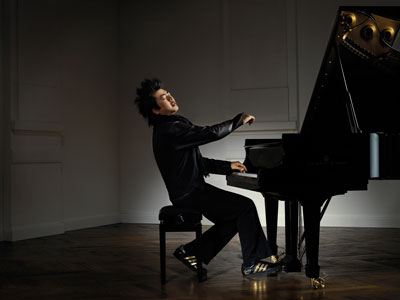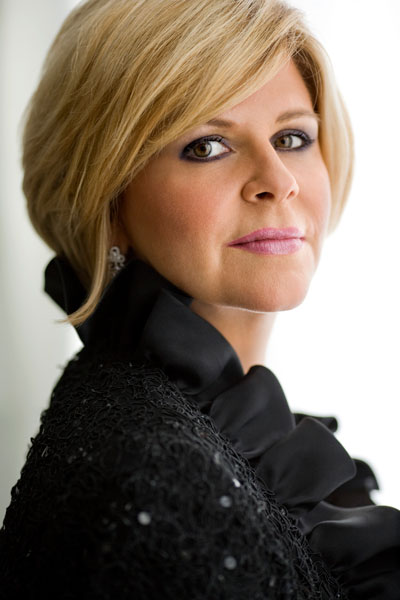I’m sure you’ll be shocked to read that I love when marketing matters
come up in critical reviews. This is funny stuff, from writer Time Out Chicago:
Head over to the Harris Theater entrance on Randolph. Observe any
instrument-lugging musician’s reaction to the Lang Lang promo on the
Harris’s video screens. If it’s anything other than eye rolling,
chances are that musician is busy texting. Attempting to channel his
inner Run-DMC with a pair of glistening black Adidas, the Chinese
pianist’s head is thrown back in a moment of perfectly staged,
grotesquely self-involved ecstasy. It’s not that classical music
couldn’t benefit from some image upgrades, but it’s hard to see this as
anything other than a product.
Not having seen it for myself in Chicago, I would guess this is the photo in question:

goes on to write:
Fortunately, most classical
superstars are more focused on the quality of their technique than on
casting their eyes downward and mussing their hair. Susan Graham is one
such artist.…at worst, her publicity shots resemble your eccentric aunt from Santa Barbara.
…With her uninhibited navigation of the French texts and effortless
movement among the cabaret, the salon and the grave top in these songs,
the profundity is reserved for the concert, rather than the photo
session.
 It seems every time a classical artist gives themselves or gets that “image upgrade”, they are criticized for it. Sure, glistening golden sneakers and a violin where a bra (or perhaps a shirt) should be may not have been the best photo concepts on the planet, but these artists are doing something different and presumably – for better or worse – accurately reflecting themselves. Lang Lang likes sneakers and that’s how he plays the piano; truth in advertising, like the truth or not.
It seems every time a classical artist gives themselves or gets that “image upgrade”, they are criticized for it. Sure, glistening golden sneakers and a violin where a bra (or perhaps a shirt) should be may not have been the best photo concepts on the planet, but these artists are doing something different and presumably – for better or worse – accurately reflecting themselves. Lang Lang likes sneakers and that’s how he plays the piano; truth in advertising, like the truth or not.
Susan Graham’s “eccentric aunt” photos may have been her version of an image upgrade. An artist not wearing his or her glasses in a photo, or not sitting in front of a piano (“I play the piano, and to prove it, I will sit in front of one in this photo.”) may be versions of upgrades. But the drastic image changes, call them upgrades or even downgrades, are very quickly dismissed as distracting, as eye-roll generating. Susan Graham looking like your aunt in photos does not make her a great artist. She happens to be a great artist, but one thing has nothing to do with the other.
Touring classical musicians are public figures, and with that should come a degree of image awareness and attention. Why then, when an artist has publicity photos that demonstrate an awareness of style, wears concert attire that he or she is comfortable performing in, or has a less traditional haircut, does it necessarily mean he or she is less focused or less committed to The Art? Anne-Sophie Mutter starts wearing strapless gowns and the press talks about it for a decade. Anna Netrekbo is style savvy and beautiful; surely that means she has a less powerful instrument. But X Opera Star is overweight and hasn’t taken a new press photo since 1976: now THERE’s an ARTIST! Time spent shopping, at personal trainer sessions and at make-up consultations are not necessarily hours that could be spent at voice lessons. This Image Conscious v. Serious Artist debate seems exclusive to our special industry. Yes, an actor or actress may be criticized for a bad red carpet style decision, but that commentary does not extend to a discussion about his or her acting abilities or role decisions.
Classical musicians are damned if they do and damned if they don’t. Those who make new aesthetic decisions are criticized and mocked, while artists who remain aesthetically constant will garner complaints from – let’s call it/us the “far left”; they’re not reaching new audiences, they’re catering to the old guard, they’re boring. What I care about, as mentioned above, is honest reflections: if that photo/outfit/haircut is you, then go for it with the highest degree of quality you can, and pay no mind to the eye-rolls on either side of the divide.

You say “eccentric aunt”; I say “very HOT…and intriguing”!
Nice writing and excellent points. If the performances are sincere, convincing
and memorable, they should be able to wear anything.
Interestingly enough, I met a well-known artist who did not resemble their press shots at all — considerably more stunning — and genuine — in person than the image presented in the press “look.” (And by the way, this is a truly superb, gifted musician.)
For our interview with Lang Lang, I asked him about his particular stage presence. Here’s what he said. (I’ve taken out a few repeated words and restarts.)
“That’s who I am you know, I mean that’s my style. When I was playing you know, six years old I mean I played the same way and I think this doesn’t matter because you look at like the last century, and the top 50 pianists, and they all looked very different when they played. Glenn Gould played like that; and then Horowitz played like other way, and then Claudio Arrau plays, you know. When you look at them, they all have their own, not only sound, but also physical movement. The important thing is what kind of sound you produce, what kind of feelings…style you produce through music. That counts more. And for me, one thing I’m very clear is that I never made a movement. It comes from my heart.”
David
I think the “damned if you do, damned if you don’t” is a symptom of the celebrity culture. Everyone has an opinion about public figures, regardless of the industry. Classical musicians may have unique challenges in terms of the particular kinds of criticism they receive about managing their image, but the problem is across the board. People like to complain.